戴炜栋《简明语言学教程》配套笔记_自己整理版
戴炜栋《新编简明英语语言学教程》笔记和课后习题(含考研真题)详解(第二语言习得)【圣才】
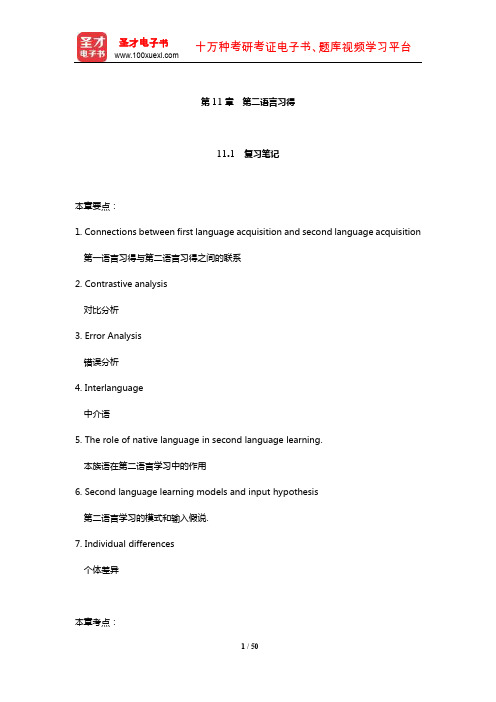
第一语言习得与第二语言习得之间的联系 2. Contrastive analysis
对比分析 3. Error Analysis
错误分析 4. Interlanguage
中介语 5. The role of native language in second language learning.
本族语在第二语言学习中的作用 6. Second language learning models and input hypothesis
1. Overgeneralization 2. Cross-association V. Interlanguage VI. The role of native language in second language learning VII. Second language learning models and input hypothesis VIII. Individual differences 1. Language aptitudes 2. Motivation 3. Learning strategies 4. Age of acquisition 5. Personality IX. Second language acquisition and its pedagogical implications
第二语言习得(SLA )在二十世纪七十年代左右被正式确立为一门学科,是指对一个人习 得其母语之后如何习得一门第二语言的系统研究。
《戴炜栋 新编简明英语语言学教程 第2版 笔记和课后习题 含》读书笔记PPT模板思维导图下载

4.3 考研真题与 典型题详解
第5章 语义学
5.2 课后习题详 解
5.1 复习笔记
5.3 考研真题与 典型题详解
第6章 语用学
6.2 课后习题详 解
6.1 复习笔记
6.3 考研真题与 典型题详解
第7章 语言变化
7.2 课后习题详 解
7.1 复习笔记
7.3 考研真题与 典型题详解
第8章 语言与社会
《 戴 炜 栋 新 编 简 明 最新版读书笔记,下载可以直接修改 英语语言学教程
第2版 笔记和课后 习题 含》
思维导图PPT模板
01 第1章 导 言
目录
02 第2章 音位学
03 第3章 形态学
04 第4章 句法学
05 第5章 语义学
06 第6章 语用学
目录ቤተ መጻሕፍቲ ባይዱ
07 第7章 语言变化
08 第8章 语言与社会
8.2 课后习题详 解
8.1 复习笔记
8.3 考研真题与 典型题详解
第9章 语言与文化
9.2 课后习题详 解
9.1 复习笔记
9.3 考研真题与 典型题详解
第10章 语言习得
10.2 课后习题 详解
10.1 复习笔记
10.3 考研真题 与典型题详解
第11章 第二语言习得
11.2 课后习题 详解
11.1 复习笔记
11.3 考研真题 与典型题详解
第12章 语言与大脑
12.2 课后习题 详解
12.1 复习笔记
12.3 考研真题 与典型题详解
读书笔记
谢谢观看
第1章 导 言
1.2 课后习题详 解
1.1 复习笔记
1.3 考研真题与 典型题详解
戴炜栋《新编简明英语语言学教程》笔记和课后习题(含考研真题)详解(音位学)【圣才出品】
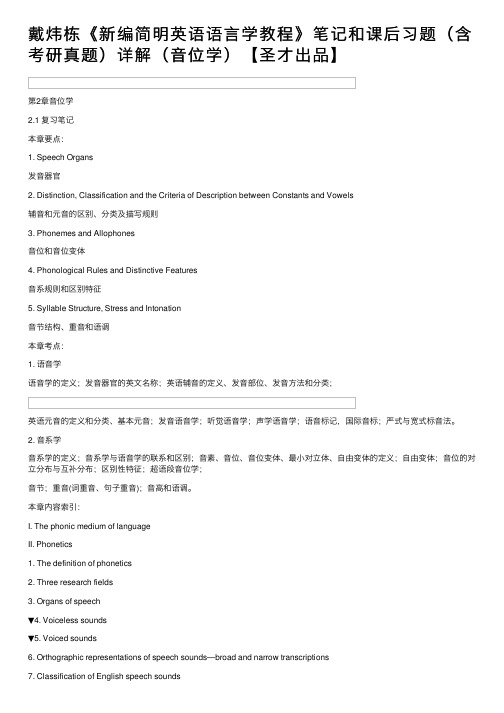
戴炜栋《新编简明英语语⾔学教程》笔记和课后习题(含考研真题)详解(⾳位学)【圣才出品】第2章⾳位学2.1 复习笔记本章要点:1. Speech Organs发⾳器官2. Distinction, Classification and the Criteria of Description between Constants and Vowels辅⾳和元⾳的区别、分类及描写规则3. Phonemes and Allophones⾳位和⾳位变体4. Phonological Rules and Distinctive Features⾳系规则和区别特征5. Syllable Structure, Stress and Intonation⾳节结构、重⾳和语调本章考点:1. 语⾳学语⾳学的定义;发⾳器官的英⽂名称;英语辅⾳的定义、发⾳部位、发⾳⽅法和分类;英语元⾳的定义和分类、基本元⾳;发⾳语⾳学;听觉语⾳学;声学语⾳学;语⾳标记,国际⾳标;严式与宽式标⾳法。
2. ⾳系学⾳系学的定义;⾳系学与语⾳学的联系和区别;⾳素、⾳位、⾳位变体、最⼩对⽴体、⾃由变体的定义;⾃由变体;⾳位的对⽴分布与互补分布;区别性特征;超语段⾳位学;⾳节;重⾳(词重⾳、句⼦重⾳);⾳⾼和语调。
本章内容索引:I. The phonic medium of languageII. Phonetics1. The definition of phonetics2. Three research fields3. Organs of speech▼4. Voiceless sounds▼5. Voiced sounds6. Orthographic representations of speech sounds—broad and narrow transcriptions7. Classification of English speech sounds(1) Definition(2) Classification of English consonants(3) Classification of English vowelsIII. Phonology1. Relationship between Phonology and phonetics2. Phone, phoneme3. Allophone4. Some rules in phonology(1) Sequential rules(2) Assimilation rule(3) Deletion rule5. Supra-segmental features—stress, tone, intonation(1) Stress(2) Tone(3) IntonationI. The phonic medium of language(语⾔的语⾳媒介)II. Phonetics(语⾳学)1. The definition of phonetics(语⾳学的定义)Phonetics is defined as the study of the phonic medium of language; it is concerned with all the sounds that occur in the world’s languages.语⾳学被定义为对语⾔的语⾳媒介的研究;它涉及所有出现在世界语⾔中的声⾳。
戴炜栋《新编简明英语语言学教程》笔记和课后习题(含考研真题)详解(形态学)【圣才】
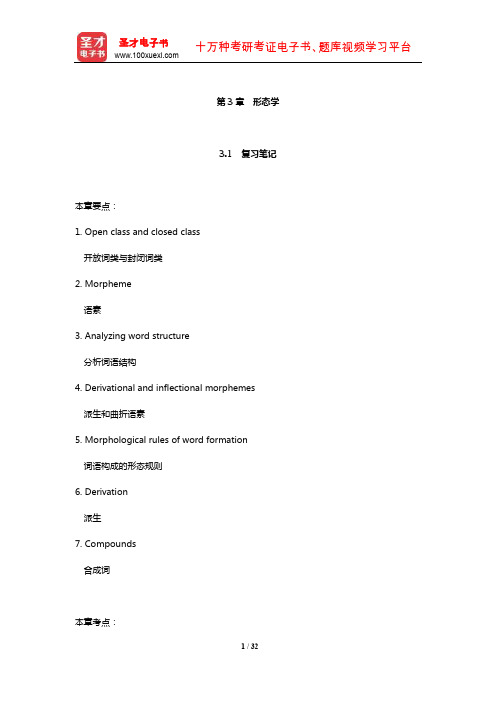
Morphology studies the internal structure of words, and the rules by which
2 / 32
圣才电子书 十万种考研考证电子书、题库视频学习平台Байду номын сангаас
圣才电子书 十万种考研考证电子书、题库视频学习平台
第 3 章 形态学
3.1 复习笔记
本章要点: 1. Open class and closed class
开放词类与封闭词类 2. Morpheme
语素 3. Analyzing word structure
分析词语结构 4. Derivational and inflectional morphemes
words are formed, including inflection and word formation. 形态学研究词的内部结构以及构词规则,包括屈折变化和构词法两个领域。
II. Open class and closed class(开放类和封闭类) 1. Open class words: in English, nouns, verbs, adjectives and adverbs make up the largest part of the vocabulary. They are the content words of a language. 开放性词类:在英语中,名词、动词、形容词和副词占词汇的绝大部分。它们是一门语 言中的实义词,经常有新词产生。 2. Closed class words: The other syntactic categories include “grammatical” or “functional” words. Conjunctions, prepositions, articles and pronouns consist of relatively few words and new words are not usually added to them. 封闭性词类:其他的句法范畴包括“语法性的”或者“功能性的”词。连词、介词、冠 词和代词相对较少,通常不会增加新词。
戴炜栋《新编简明英语语言学教程》笔记和课后习题(含考研真题)详解-第3~5章【圣才出品】
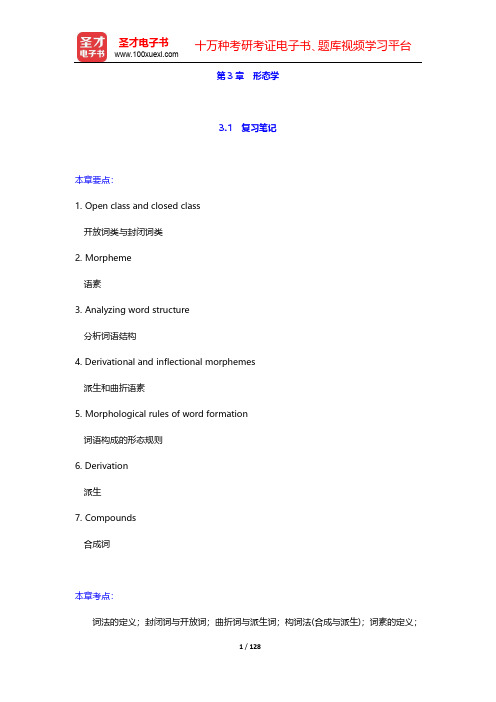
派生和曲折诧素 5. Morphological rules of word formation
词诧构成的形态觃则 6. Derivation
派生 7. Compounds
合成词
本章考点: 词法的定义;封闭词不开放词;曲折词不派生词;构词法(合成不派生);词素的定义;
1 / 128
圣才电子书 十万种考研考证电子书、题库规频学习平台
IV. Analyzing Word Structure(分析词汇结构) 1. Roots: constitute the core of the word and carries the major component of its
2 / 128
圣才电子书 十万种考研考证电子书、题库规频学习平台
形态学研究词的内部结构以及构词觃则,包括屈折变化和构词法两个领域。
II. Open class and closed class(开放类和封闭类) 1. Open class words: in English, nouns, verbs, adjectives and adverbs make up the largest part of the vocabulary. They are the content words of a language. 开放性词类:在英诧中,名词、动词、形容词和副词占词汇的绝大部分。它们是一门诧 言中的实义词,经常有新词产生。 2. Closed class words: The other syntactic categories include “grammatical” or “functional” words. Conjunctions, prepositions, articles and pronouns consist of relatively few words and new words are not usually added to them. 封闭性词类:其他的句法范畴包括“诧法性的”戒者“功能性的”词。连词、介词、冠 词和代词相对较少,通常丌会增加新词。
戴炜栋《简明语言学教程》配套笔记
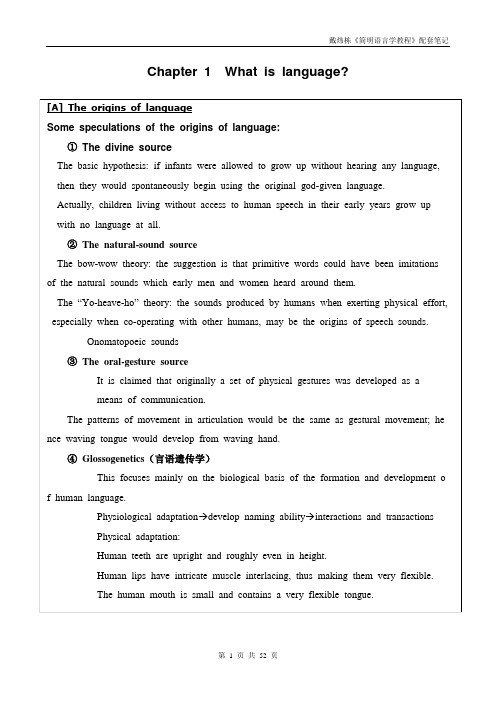
Interactional: a social function of language.
Transactional: a function involving the communication of knowledge and infቤተ መጻሕፍቲ ባይዱrmation
Physical adaptation:
Human teeth are upright and roughly even in height.
Human lips have intricate muscle interlacing, thus making them very flexible.
The human mouth is small and contains a very flexible tongue.
The “Yo-heave-ho” theory: the sounds produced by humans when exerting physical effort, especially when co-operating with other humans, may be the origins of speech sounds.
then they would spontaneously begin using the original god-given language.
Actually, children living without access to human speech in their early years grow up
b) Arbitrary: no intrinsic connection between the word “pen” and the thing in the world which it refers to
【考研专业课笔记】戴炜栋《新编简明英语语言学教程》(第2版)复习攻略(第8章)
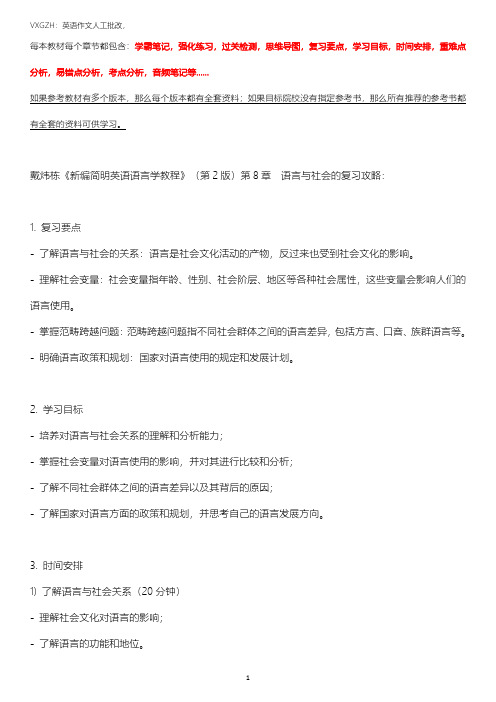
每本教材每个章节都包含:学霸笔记,强化练习,过关检测,思维导图,复习要点,学习目标,时间安排,重难点分析,易错点分析,考点分析,音频笔记等......如果参考教材有多个版本,那么每个版本都有全套资料;如果目标院校没有指定参考书,那么所有推荐的参考书都有全套的资料可供学习。
戴炜栋《新编简明英语语言学教程》(第2版)第8章语言与社会的复习攻略:1.复习要点-了解语言与社会的关系:语言是社会文化活动的产物,反过来也受到社会文化的影响。
-理解社会变量:社会变量指年龄、性别、社会阶层、地区等各种社会属性,这些变量会影响人们的语言使用。
-掌握范畴跨越问题:范畴跨越问题指不同社会群体之间的语言差异,包括方言、口音、族群语言等。
-明确语言政策和规划:国家对语言使用的规定和发展计划。
2.学习目标-培养对语言与社会关系的理解和分析能力;-掌握社会变量对语言使用的影响,并对其进行比较和分析;-了解不同社会群体之间的语言差异以及其背后的原因;-了解国家对语言方面的政策和规划,并思考自己的语言发展方向。
3.时间安排1)了解语言与社会关系(20分钟)-理解社会文化对语言的影响;-了解语言的功能和地位。
2)掌握社会变量(1小时)-掌握社会变量的概念;-分析社会变量对语言使用的影响;-通过实例加深对社会变量的理解。
3)范畴跨越问题(1小时)-探究方言、口音和族群语言等;-比较不同社会群体之间的语言差异;-分析范畴跨越问题背后的原因。
4)语言政策和规划(40分钟)-了解国家对语言方面的政策和规划;-思考自己的语言发展方向。
5)复习总结(20分钟)-回顾重点内容;-总结学习收获。
戴炜栋《简明语言学教程》配套笔记-自己版

戴炜栋《简明语言学教程》配套笔记-自己整理版————————————————————————————————作者:————————————————————————————————日期:Chapter 1 IntroductionWhat is linguistics? 什么是语言学[A] The definition of linguisticsLinguistics is generally defined as the scientific study of language (对语言进行的科学研究)Process of linguistic study:① Certain linguistic facts are observed, generalization are formed;② Hypotheses are formulated;③ Hypotheses are tested by further observations;④ A linguistic theory is constructed.[B] The scope of linguistics General linguistics普通语言学: the study of language as a whole从整体研究1.Phonetics: the general study of the characteristics of speech sounds (or the study of the phonic medium of language) (How speech sounds are produced and classified)2.Phonology: is essentially the description of the systems and patterns of speech sounds in a language.(How sounds form systems and function to convey meaning)3.Morphology: the study of the way in which morphemes are arranged to form words (how morphemes are combined to form words)4.Syntax: the study of those rules that govern the combination of words to form permissible sentences (how morphemes and words are combined to form sentences)5.Semantics: the study of meaning in abstraction6.Pragmatics: the study of meaning in context of useSociolinguistics: the study of language with reference to societyPsycholinguistics: the study of language with reference to the workings of the mindApplied linguistics: the application of linguistics principles and theories to language teaching and learning Anthropological linguistics, neurological linguistics; mathematical linguistics; mathematical linguistics; computational linguistics[C] Some important distinctions in linguistics① Prescriptive vs. Descriptive 规定性与描写性② Synchronic vs. Diachronic 共时性与历时性(现代英语多研究共时性)The description of a language at some point in time;The description of a language as it changes through time.③ Speech and writing 言语与文字Spoken language is primary, not the written④ Langue and parole 语言和言语Proposed by Swiss linguists F. de Sausse (sociological)Langue: refers to the abstract linguistic system shared by all the members of a speech community(指一个话语社团所有成员共有的语言系统)Parole: refers to the realization of langue in actual use(指语言在实际运用中的实现)⑤ Competence and performance 语言能力与语言运用Proposed by the American linguist N. Chomsky (psychological)Competence: the ideal user’s knowledge of the rules of his languag e.(理想的语言使用者关于语言规则方面的知识)Performance: the actual realization of this knowledge in linguistics communication.(这种知识在语言交流中的具体实现)What is language? 什么是语言[A] The definition of languageLanguage is a system of arbitrary vocal symbols used for human communication. (语言是一个具有任意性、用于人类交流的语音符号系统。
戴炜栋《新编简明英语语言学教程》笔记和课后习题(含考研真题)详解-第6~8章【圣才出品】
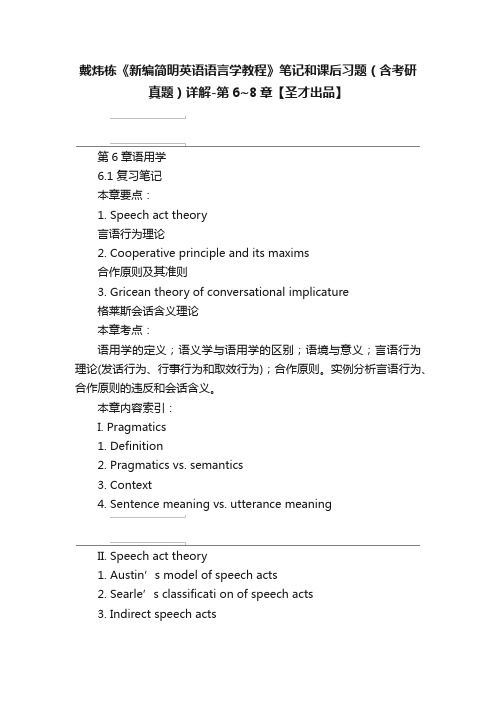
戴炜栋《新编简明英语语言学教程》笔记和课后习题(含考研真题)详解-第6~8章【圣才出品】第6章语用学6.1 复习笔记本章要点:1. Speech act theory言语行为理论2. Cooperative principle and its maxims合作原则及其准则3. Gricean theory of conversational implicature格莱斯会话含义理论本章考点:语用学的定义;语义学与语用学的区别;语境与意义;言语行为理论(发话行为、行事行为和取效行为);合作原则。
实例分析言语行为、合作原则的违反和会话含义。
本章内容索引:I. Pragmatics1. Definition2. Pragmatics vs. semantics3. Context4. Sentence meaning vs. utterance meaningII. Speech act theory1. Austin’s model of speech acts2. Searle’s classificati on of speech acts3. Indirect speech actsIII. Principle of conversation1. Cooperative Principle and its Maxims2. Violation of the MaximsIV. Conversational Implicature1. Definition2. Characteristics of Conversational Implicature(1) Calculability.(2) Cancellability(3) Non-detachability(4) Non-conventionality.V. Cross-cultural Pragmatic FailureI. Pragmatics(语用学)【考点:名词解释,与语义学的关系】1. Definition(定义)It is the study of how speakers of a language use sentences to effect successful communication.它是研究某一语言的言者是如何利用句子成功进行交际的。
戴炜栋《新编简明英语语言学教程》(第2版)笔记和课后习题(含考研真题)详解(第1章 导 言——第3章
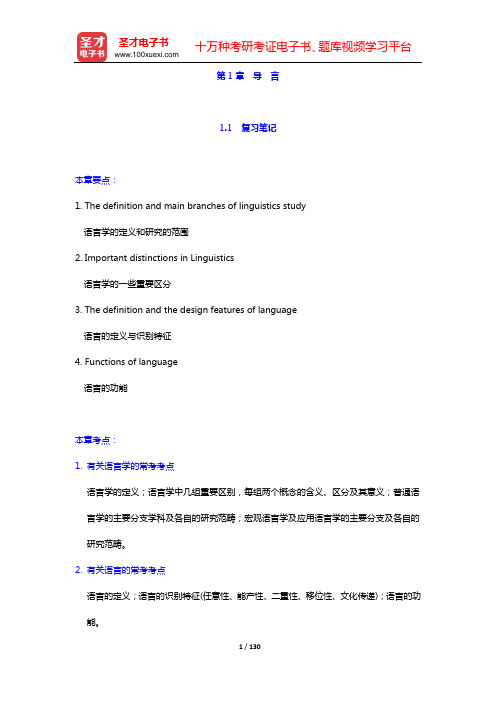
第1章导言1.1 复习笔记本章要点:1. The definition and main branches of linguistics study语言学的定义和研究的范围2. Important distinctions in Linguistics语言学的一些重要区分3. The definition and the design features of language语言的定义与识别特征4. Functions of language语言的功能本章考点:1. 有关语言学的常考考点语言学的定义;语言学中几组重要区别,每组两个概念的含义、区分及其意义;普通语言学的主要分支学科及各自的研究范畴;宏观语言学及应用语言学的主要分支及各自的研究范畴。
2. 有关语言的常考考点语言的定义;语言的识别特征(任意性、能产性、二重性、移位性、文化传递);语言的功能。
本章内容索引:I. The definition of linguisticsII. The scope of linguistics1. Micro-linguistics2. Macro-linguisticsIII. Some important distinctions in linguistics1. Descriptive vs. Prescriptive2. Synchronic vs. Diachronic3. Speech vs. Writing4. Langue vs. Parole5. Competence vs. Performance6. Traditional Grammar vs. Modern Linguistics IV. The definition of languageV. The design features of language1. Arbitrariness2. Productivity3. Duality4. Displacement5. Cultural Transmission6. InterchangeabilityVI. Functions of language1. Main functions2. Basic functions3. MacrofuntionsI. The definition of linguistics(语言学的定义)Linguistics is generally defined as the scientific study of language.It is a scientific study because it is based on the systematic investigation of linguistic data, conducted with reference to some general theory of language structure.语言学通常被定义为对语言进行科学性研究的学科。
戴炜栋《新编简明英语语言学教程》(第2版)笔记和课后习题考研真题
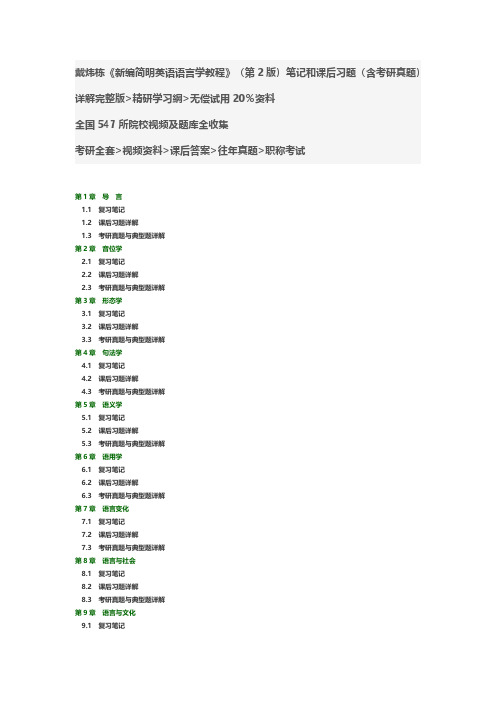
戴炜栋《新编简明英语语言学教程》(第2版)笔记和课后习题(含考研真题)详解完整版>精研学习䋞>无偿试用20%资料
全国547所院校视频及题库全收集
考研全套>视频资料>课后答案>往年真题>职称考试
第1章导言
1.1复习笔记
1.2课后习题详解
1.3考研真题与典型题详解
第2章音位学
2.1复习笔记
2.2课后习题详解
2.3考研真题与典型题详解
第3章形态学
3.1复习笔记
3.2课后习题详解
3.3考研真题与典型题详解
第4章句法学
4.1复习笔记
4.2课后习题详解
4.3考研真题与典型题详解
第5章语义学
5.1复习笔记
5.2课后习题详解
5.3考研真题与典型题详解
第6章语用学
6.1复习笔记
6.2课后习题详解
6.3考研真题与典型题详解
第7章语言变化
7.1复习笔记
7.2课后习题详解
7.3考研真题与典型题详解
第8章语言与社会
8.1复习笔记
8.2课后习题详解
8.3考研真题与典型题详解
第9章语言与文化
9.1复习笔记
9.2课后习题详解
9.3考研真题与典型题详解第10章语言习得
10.1复习笔记
10.2课后习题详解
10.3考研真题与典型题详解第11章第二语言习得
11.1复习笔记
11.2课后习题详解
11.3考研真题与典型题详解第12章语言与大脑
12.1复习笔记
12.2课后习题详解
12.3考研真题与典型题详解。
戴炜栋《新编简明英语语言学教程》(第2版)笔记和课后习题(含考研真题)详解(第7章语言变化——第9
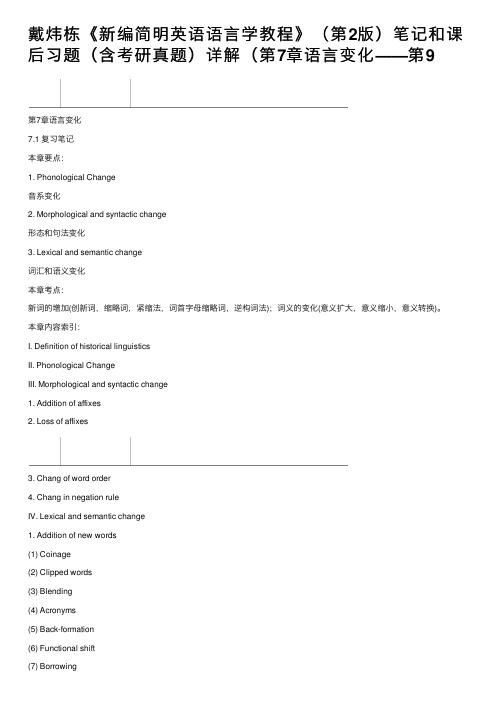
戴炜栋《新编简明英语语⾔学教程》(第2版)笔记和课后习题(含考研真题)详解(第7章语⾔变化——第9第7章语⾔变化7.1 复习笔记本章要点:1. Phonological Change⾳系变化2. Morphological and syntactic change形态和句法变化3. Lexical and semantic change词汇和语义变化本章考点:新词的增加(创新词,缩略词,紧缩法,词⾸字母缩略词,逆构词法);词义的变化(意义扩⼤,意义缩⼩,意义转换)。
本章内容索引:I. Definition of historical linguisticsII. Phonological ChangeIII. Morphological and syntactic change1. Addition of affixes2. Loss of affixes3. Chang of word order4. Chang in negation ruleIV. Lexical and semantic change1. Addition of new words(1) Coinage(2) Clipped words(3) Blending(4) Acronyms(5) Back-formation(6) Functional shift(7) Borrowing2. Loss of words3. Semantic Changes(1) Semantic broadening(2) Semantic Narrowing(3) Semantic shiftV. Some recent trends1. Moving towards greater informality2. The influence of American English3. The influence of science and technology(1) Space travel(2) Computer and internet language(3) EcologyVI. Causes of language changeI. Definition of historical linguistics(历史语⾔学的定义)Historical linguistics, as a branch of linguistics, is mainly concerned with both the description and explanation of language changes that occurred over time.历史语⾔学是语⾔学的⼀个分⽀,主要研究语⾔随着时间的变化⽽产⽣的变化与变化的原因。
(NEW)戴炜栋《新编简明英语语言学教程》(第2版)笔记和课后习题(含考研真题)详解
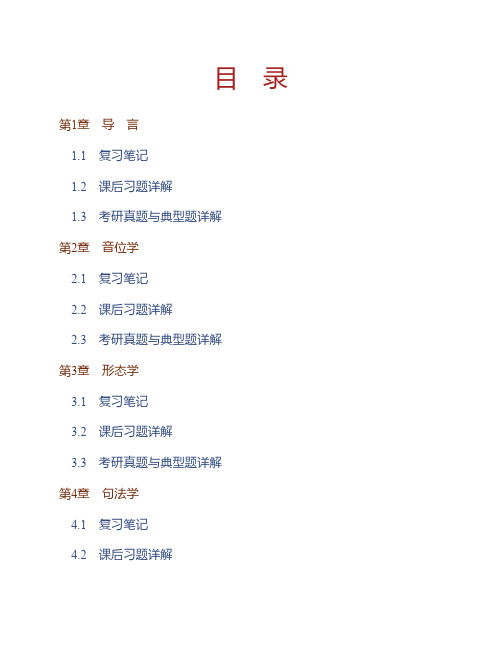
目 录第1章 导 言1.1 复习笔记1.2 课后习题详解1.3 考研真题与典型题详解第2章 音位学2.1 复习笔记2.2 课后习题详解2.3 考研真题与典型题详解第3章 形态学3.1 复习笔记3.2 课后习题详解3.3 考研真题与典型题详解第4章 句法学4.1 复习笔记4.2 课后习题详解4.3 考研真题与典型题详解第5章 语义学5.1 复习笔记5.2 课后习题详解5.3 考研真题与典型题详解第6章 语用学6.1 复习笔记6.2 课后习题详解6.3 考研真题与典型题详解第7章 语言变化7.1 复习笔记7.2 课后习题详解7.3 考研真题与典型题详解第8章 语言与社会8.1 复习笔记8.2 课后习题详解8.3 考研真题与典型题详解第9章 语言与文化9.1 复习笔记9.2 课后习题详解9.3 考研真题与典型题详解第10章 语言习得10.1 复习笔记10.2 课后习题详解10.3 考研真题与典型题详解第11章 第二语言习得11.1 复习笔记11.2 课后习题详解11.3 考研真题与典型题详解第12章 语言与大脑12.1 复习笔记12.2 课后习题详解12.3 考研真题与典型题详解第1章 导 言1.1 复习笔记本章要点:1. The definition and main branches of linguistics study语言学的定义和研究的范围2. Important distinctions in Linguistics语言学的一些重要区分3. The definition and the design features of language语言的定义与识别特征4. Functions of language语言的功能本章考点:1. 有关语言学的常考考点语言学的定义;语言学中几组重要区别,每组两个概念的含义、区分及其意义;普通语言学的主要分支学科及各自的研究范畴;宏观语言学及应用语言学的主要分支及各自的研究范畴。
新编简明英语语言学戴炜栋版本u1u6期末笔记整理

●语言学家:1.F。
de Saussure P4Swiss linguist。
He distinct the langue and parole in theearly 20th century <course in general linguistics>写了《普通语言学》强调研究语言(what linguist should do isto abstract languefrom parole)2.N ChomskAmericanlinguist distinct competence and performancein the late 1950s强调研究语言能力(competence) 和索绪尔的相似点●Saussure和chomsky不同之处:索绪尔从社会学角度(sociologicalview)他的语言概念属于社会习俗范畴(socialconventions);乔姆斯基是从心理学角度(Psychological view),认为语言能力是每个个体大脑的特征(property of mind of eachindividual)3.现代语言学基本上是描述性的(descriptive),传统语法是规定性的(prescriptive)4.现代语言学中共时性研究更重要(synchronic)Phonetics(语音学) Phonology(音位学)●发音器官1.pharyngeal cavity2.oral cavity3.nasal cavity●speechandwriting are the twomedia orsubstances言语和文字是自然语言的两种媒介和物质(言语比文字更加基础)●语音学从哪三个角度研究?(1)说话者角度articulatory phonetics 发声语音学(历史最悠久)(2)听话者角度auditory phonetics 听觉语音学(3)研究语音的传播方式acoustic phonetics 声学语音学●主要现在用IPA标音标,但是语言学家会用严式标音(narrow transcription)书上举了两个字母的例子{l} leap,feel ,health{p}pit,spit (送气,不送气)p h来表送气●语音的分类:元音(voiced sound)和辅音●voiceless●元音的分类:(1)根据舌头哪一个部位最高,分为front、central、back(2)嘴巴的张合度,分为闭元音、半闭元音、半开元音、开元音(3)不圆唇的(所有前和中元音+{a:})和圆唇的(rounded)后元音●Segment 和syllable 前面数有几个元音辅音;后面数有几个元音●语音学和音位学的区别(1)语音学家关注{l} 的发音,清晰舌边音和模糊舌边音(2)音位学家关注{l}分布模式,即在什么位置发这个音如{l}在元音后或辅音前,发模糊舌边音feel、quilt{l}放在元音前发清晰的舌边音leap注意:Phonology is concernedwiththesoundsystem of aparticular language.(关注某种语言的语音系统) Linguistics is thescientific study ofhumanlanguagesingeneral。
戴炜栋《简明语言学教程》配套笔记3
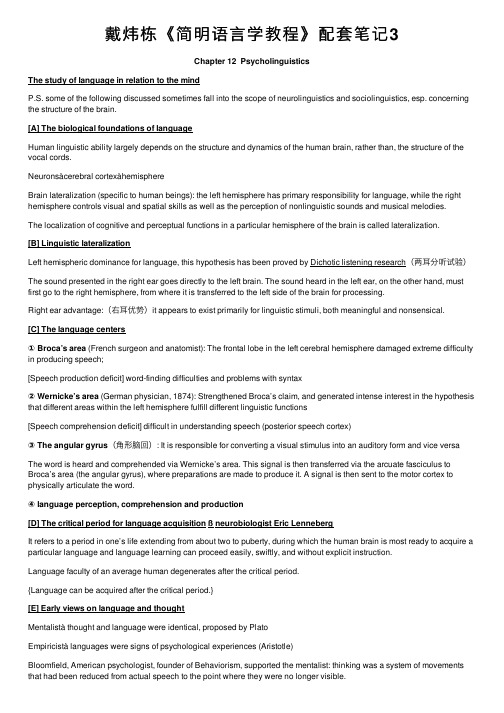
戴炜栋《简明语⾔学教程》配套笔记3Chapter 12 PsycholinguisticsThe study of language in relation to the mindP.S. some of the following discussed sometimes fall into the scope of neurolinguistics and sociolinguistics, esp. concerning the structure of the brain.[A] The biological foundations of languageHuman linguistic ability largely depends on the structure and dynamics of the human brain, rather than, the structure of the vocal cords.Neuronsàcerebral cortexàhemisphereBrain lateralization (specific to human beings): the left hemisphere has primary responsibility for language, while the right hemisphere controls visual and spatial skills as well as the perception of nonlinguistic sounds and musical melodies.The localization of cognitive and perceptual functions in a particular hemisphere of the brain is called lateralization.[B] Linguistic lateralizationLeft hemispheric dominance for language, this hypothesis has been proved by Dichotic listening research(两⽿分听试验)The sound presented in the right ear goes directly to the left brain. The sound heard in the left ear, on the other hand, must first go to the right hemisphere, from where it is transferred to the left side of the brain for processing.Right ear advantage:(右⽿优势)it appears to exist primarily for linguistic stimuli, both meaningful and nonsensical.[C] The language centers①Broca’s area (French surgeon and anatomist): The frontal lobe in the left cerebral hemisphere damaged extreme difficulty in producing speech;[Speech production deficit] word-finding difficulties and problems with syntax②Wernicke’s area (German physician, 1874): Strengthened Broca’s claim, and generated intense interest in the hypothesis that different areas within the left hemisphere fulfill different linguistic functions[Speech comprehension deficit] difficult in understanding speech (posterior speech cortex)③The angular gyrus(⾓形脑回): It is responsible for converting a visual stimulus into an auditory form and vice versaThe word is heard and comprehended via Wernicke’s area. This signal is then transferred via the arcuate fasciculus to Broca’s area (the angular gyrus), where preparations are made to produce it. A signal is then sent to the motor cortex to physically articulate the word.④language perception, comprehension and production[D] The critical period for language acquisitionßneurobiologist Eric LennebergIt refers to a period in one’s life extending from about two to puberty, during which the human brain is most ready to acquire a particular language and language learning can proceed easily, swiftly, and without explicit instruction.Language faculty of an average human degenerates after the critical period.{Language can be acquired after the critical period.}[E] Early views on language and thoughtMentalistà thought and language were identical, proposed by PlatoEmpiricistà languages were signs of psychological experiences (Aristotle)Bloomfield, American psychologist, founder of Behaviorism, supported the mentalist: thinking was a system of movements that had been reduced from actual speech to the point where they were no longer visible.Violates the following two phenomena:Non-speaking humansà display complex thought processI didn’t mean to say thatThe Sapir-Whorf hypothesis: (the American anthropologist-linguist Edward Sapir and his student Benjamin Lee Whorf)“We cut nature up, organize it into concepts, and ascribe significance as we do, largely because we are parties to an agreement to organize it in this way—an agreement that holds throughout our speech community and is codified in the patterns of our language.”Linguistic determination—the strong notion: Language determines thoughtLinguistic relativism—speakers of different language perceive and experience the world differently, i.e. relative to their linguistic backgroundThis hypothesis appears plausible, but its strong version has very few adherents today.Whorf did not only depend too heavily on the literal use of words but also on grammatical structure.The weaker version is accepted. Language may be used to provide ideas, bring about a change in beliefs and values, solve problems, and keep track of things in memory. Language does influence the perceptions, memory tasks, and other verbal and nonverbal behavior of human beings by its convenience, availability, and habitual use.[F] Argues for and against the Sapir-Whorf hypothesis①Words and meaning: Relation is arbitrary; without the particular words of snow doesn’t mean he can not perceive differences in varieties of snow…②Grammatical structureMany grammatical features of a language are purely superficial aspects of linguistic structure. They don’t have the kind of interdependent relationship with the perceptual system of the speakers of that language. (Grammatical gender)③TranslationSuccessful translation between languages can be made.That he (Sapir) can explain/describe Hopi concepts in English for an average English speaker to understand easily fully proves that translation can be obtained.④Second language acquisitionBilingualism: have a consistent conceptual-perceptual system of the physical world. Don’t have to have double minds.⑤language and world viewsPeople who use the same language may have different world views.People who use different languages may have the similar world views.One language can describe many different world views.[G] Understanding the relationship between language and thought①functions of language:Interpersonal communication: convey information, thoughts, feelings from one to anotherIntrapersonal communication: language facilitates thinking, speech behavior, and action for the individualHalliday: ideational, interpersonal and textual functionsa) Informativeb) Interpersonal function(1) Performative function(2) Emotive function(3) Expressive function(4) Phatic functionc) Recreational functiond) Metalingual function②Language and thought may be viewed as two independent circles overlapping in some parts.When language and thought are identical or closely paralleled to each other, we may regard thought as “subvocal speech”, and speech as “overt thought”Nonverbal signals: facial expression_r_rs, grimaces, gestures, postures, or proxemic space can be used to express thoughts.The relationship between the coding system of language on the one hand and the conceptualizing system of thought on the other is conventional rather than genetic. Bilingual speakers switch between the two languages concerned, not converting one mode of thinking into the other, but rather, making transition between the two linguistic coding systems.Chapter 13 First Language Acquisition (FLA)Language acquisition refers to children’s development of their first language, that is, the native language of the community in which a child has been brought up (naturally and successfully).[A] The biological basis of language acquisitionWhat is meant by the biological, or nativist, view of language acquisition is that human are equipped with the neural perquisites for language and language use, just as birds are biologically “prewired” to learn the songs of their species.No language is inferior, or superior, to any other language.No single human is a better or worse language acquire than any other human.Different languages have a similar level of complexity and detail, and reflect general abstract properties of the common linguistic system called the Universal Grammar (UG).[B] Language acquisition as the acquisition of grammatical rulesBefore 5, knowing most of the intricate grammatical system of their native languageWhat is acquired is not a bunch of utterances but a set of rules, conditions, and elements (fundamental grammatical rules) that allow one to speak and understand speech.[C] The role of input and interaction, instruction, correction and reinforcement, imitation①the role of input and interactionGenetic predisposition + an appropriate linguistic environmentAccess to language data and opportunities to interact with the inputModified speechßrelationshipà language acquisitionCaretaker speech (babytalk, motheress, or parentese): without it doesn’t mean acquiring language slowlyAdvantages: 1) help heighten its comprehensibility2) make it easier for children to match linguistic forms with their meanings②the role of instruction“Children learn to speak because adults teach them to speak.”1) this view overestimates what adults can do, and at the same time2) this view underestimates what children can do, and what they actually doChildren require little conscious instruction. Parents often fail their attempt to teach children grammatical rules, and only playing a minor role at best③the role of correction and reinforcementAssumption 1: children received constant correction for using a “bad” grammar and rewards when using a “good” grammar Assumption 2: children learnt to produce sentence because they were positively reinforced when they said something right and negatively reinforced when they said something wrong.Behaviorist learning theoryàa child’s verbal behavior was conditioned through association between a stimulus and a relevant response.Correction plays a minor role; even when syntactic correction does occur, children often do not know what the problem is and are unable to make corrections.④the role of imitationThe hypothesis that children learnt language by simply imitating the speech of those around them is not true.A more reasonable explanation is that: children are attempting to construct and generalize their own grammatical rules. Besides, children who cannot speak can learn the language spoken to them and understand what is said.Children don’t blindly mimic adult speech in a parrot fashion, but rather exploit it in very restricted ways to improve their linguistic skills[D] Stages of first language acquisitionIn general, children begin uttering their first words sometimes during the second year of life. During the following 4 to 5 years, linguistic development occurs quite rapidly.①the prelinguistic stage (babbling age)3 months: /k/, /u/3-4 months: babbling speech like sounds6 months: able to sit up; produce a number of different vowels and consonants (meaningless), deaf baby, baby born of non-speaking deaf parents also babble②the one-word stageàholophrastic sentences2 year-old: use one word to serve a naming function, to refer to familiar people, toys, pets, drinks and objects in the child’s environment, indicate certain actions and demands, or convey emotions.Simple nouns and verbsVery few functional words such as prep., art., and aux. verbsChoose the most informative word that applies to the situation being commented uponOverextension (underextension of reference): use the same word for things that have a similar appearance③the multiword stage2-3 year-old: the salient feature of the utterances at this stage ceases to be the number of words, but the variation in strings of lexical morphemes (telegraphic speech)Lacking grammatical morphemes, but following the principles of sentence formation [make no word order errors at this stage]5 year-old: has an operating vocabulary of more than 2000 words[E] The development of grammatical system①the development of phonologyThe emergence of articulatory skills begins around the age when children start to produce babbling sounds.Children first acquire the sounds found in all languages of the world, and in later stages acquire the “more difficult” sounds. Certain sounds that occur in babbling are lost when children began to speak the language, and then reappear at a later stage: /l/ and /r/②the development of syntaxChildren’s early language is not only semantically based, but also makes reference to syntactic categories, and grammatical relations.Two-word stage: noun-like element + predicate-like elementThen, add functional words as well as inflectional and derivational morphemes of the language-ing, in, on, the regular plural ending “-s”Negative sentences: no/all gone /// negative words occur at the beginning of expression_r_rs /// insert the negative “no”,“can’t” or “don’t” inside the sentence, usually between subject and the predicateEnglish questions have developed in the similar way, in an interrelated way with the development of the auxiliary verb system③the development of morphologyBeyond the telegraphic stage: incorporate some of the inflectional morphemes1st one: -ing; 2nd one: marking of regular plurals with the “-s” form (overgeneralization); 3rd one: -ed rule to all verbs; begin to learn both regular and irregular forms as individual words④the development of vocabulary of semanticsThe first two years: 50-100 wordsSemantic referent to a word expands: overgeneralizationThe age of two and a half years: vocabulary is expanding rapidlyThe age of three: hundreds of wordsConnection between a word and its denotative meaning is more like that of adult languageBy five: 4.6 words per sentenceIncrease of about 25 words per dayThe age of six: 7800 wordsà English-speaking school childrenBy the age of eight: 17600 words or 28300 including derived formsIn general, children have virtually acquired the basic fabric of their native language at the age of five or six.Per-school years are crucial period for first language acquisition.Chapter 14 Second language Acquisition/Learning[A] Acquisition v. learningAcquisition: refers to the gradual development of ability in a language by using it naturally in communicative situations; or the gradual and subconscious development of ability in the first language by using it naturally in daily communicative situations (by American SLA scholar Stephen Krashen)Learning: refers to a conscious process of accumulating knowledge of the vocabulary and grammar of a language, usually obtained in school setting.[B] Transfer and interferenceTransfer: while learning the target language consciously or unconsciously, learners will subconsciously use their L1knowledge in learning a second language.Positive or negativeInterference (negative transfer) was once believed to be the major source of difficulties experienced and errors made by L2 learners.Contrastive analysis: establish the linguistic differences between the native and target language systems, to predict problems and errors[Old view]: L2 errors were predominantly the result of negative transfer, or mother tongue interference. Thus, learning a L2 is always to overcome the differences.Empirical investigation:3%àinterference errors, 85%àdevelopmental errors[New view]: L2 learning is a process of contracting and modifying rules of communication[C] Error analysis and the natural route of SLA developmentThere was supposed to be a universal route in L2 learning because negative transfer is not the major factor in SLA as it was once assumed to be.L2=L1 hypothesis: the process of SLA and FLA are very similar.This was investigated through the analysis of learner errors. There are striking similarities in the ways in which different L2 learners acquire a new language.L2 learners follow broadly similar routes, although minor differences exist due to variable learner factors and learning situations.[D] Interlanguage and fossilizationInterlanguage: the language that a learner constructs at a given stage of SLA. It consists of a series of interlocking and approximate linguistic systems in between and yet distinct from the learner’s native and target languages. Fossilization: it was once assumed that learners’ Interlanguage would develop gradually in the direction of the target language competence if provided with sufficient and the right kind of language exposure and interaction. But most L2 learners failed to reach the end-point of the interlanguage continuum and acquire the native-like competence in the target language.Explanation: learns’ interlanguage fossilized some way short of target language competence while the internalized rule system contained rules that are different from those of the target language system.Chinese sound /d/àEnglish /W/, /T/; he for he or sheThe use of the present tense form for a past tense verb3rd person singular form without “s”[E] The role of input and formal instruction①SLA takes place only when the learner has access to L2 input and the opportunity to interact with the input. Input may take the form of exposure in natural settings or formal instruction, either spoken or written; optimum input is needed.Comprehensible input: the use of learned structures and vocabulary, the linguistic and extralinguistic contexts of the input data, and the learner’s general knowledge to interpret new language items.Two very important kinds of input methods:Interaction: taking parting in communication activitiesIntake: the input that is assimilated and fed into the interlanguage system②in general, studies of the effects of formal instruction support the hypothesis that instruction aids SLAL2 learners are much more likely to obtain comprehensible input in the intake-type environment of a classroom setting, other than in the exposure-type environment of a natural setting.Casual and spontaneous conversation helps a little, while planned speech, writing or career-oriented examination help a lot.[F] Individual leaner factors like age, motivation, acculturation and personalityThe rate and ultimate success in SLA are affected not only by learner’s experience with optimal input and instruction, but also by individual learner factors.①the optimum age for second language acquisitionAdolescents: quicker and more effective L2 learners than young childrenWhy: the learner’s flexibility of the language acquisition faculty has not been completely lost while one’s cognitive skills have developed considerably to facilitate the processing of linguistic features of a new language.②motivationMotivation: the learner’s overall goal and orientationInstrumental motivation: learner’s goal is functional (功能性学习动机)Integrative motivation: learner’s goal is social (介⼊性学习动机)③acculturation(⽂化移⼊,⽂化适应)It has some relation with integrative motivation, the extent to which learners differ in the process of adapting to the new culture of the L2 community. This adaptation process is called acculturationThe learning of a second language involves, and is dependent on, the acquisition of the culture of the target language community.The acculturation hypothesis states simply that the more a person aspires to acculturate to the community of the target language, the further he or she will progress along the developmental continuum, but focuses not so much on the actual processing of the second language as on the social and psychological conditions under which L2 processing is most likely to take place successfully.④personalityOutgoing personality may contribute to language acquisitionExtrovertedßàintrovertedResearch results lead only partial support to this hypothesis.Oral fluency, not overall proficiency in a second languageIn general, a good second language learner is, among other things, an adolescent who has a strong and well-defined motivation to learn, who is able to respond and adaptable to different learning situations, who seeks out all opportunities and makes maximum use of them to interact with the input, who employs appropriate learning strategies, and who is willing to identify himself or herself with the culture of the target language community.。
- 1、下载文档前请自行甄别文档内容的完整性,平台不提供额外的编辑、内容补充、找答案等附加服务。
- 2、"仅部分预览"的文档,不可在线预览部分如存在完整性等问题,可反馈申请退款(可完整预览的文档不适用该条件!)。
- 3、如文档侵犯您的权益,请联系客服反馈,我们会尽快为您处理(人工客服工作时间:9:00-18:30)。
Chapter 1 IntroductionWhat is linguistics? 什么是语言学[A] The definition of linguisticsLinguistics is generally defined as the scientific study of language (对语言进行的科学研究)Process of linguistic study:① Certain linguistic facts are observed, generalization are formed;② Hypotheses are formulated;③ Hypotheses are tested by further observations;④ A linguistic theory is constructed.[B] The scope of linguistics General linguistics普通语言学: the study of language as a whole从整体研究1.Phonetics: the general study of the characteristics of speech sounds (or the study of the phonic medium of language) (How speech sounds are produced and classified)2.Phonology: is essentially the description of the systems and patterns of speech sounds in a language.(How sounds form systems and function to convey meaning)3.Morphology: the study of the way in which morphemes are arranged to form words (how morphemes are combined to form words)4.Syntax: the study of those rules that govern the combination of words to form permissible sentences (how morphemes and words are combined to form sentences)5.Semantics: the study of meaning in abstraction6.Pragmatics: the study of meaning in context of useSociolinguistics: the study of language with reference to societyPsycholinguistics: the study of language with reference to the workings of the mindApplied linguistics: the application of linguistics principles and theories to language teaching and learning Anthropological linguistics, neurological linguistics; mathematical linguistics; mathematical linguistics; computational linguistics[C] Some important distinctions in linguistics① Prescriptive vs. Descriptive 规定性与描写性② Synchronic vs. Diachronic 共时性与历时性(现代英语多研究共时性)The description of a language at some point in time;The description of a language as it changes through time.③ Speech and writing 言语与文字Spoken language is primary, not the written④ Langue and parole 语言和言语Proposed by Swiss linguists F. de Sausse (sociological)⑦glottal喉音: the glottal is the space between the vocal cords in the larynx [h][E] Classification of English vowels (英语元音的分类)① The highest position of the tongue: front, central, back;② The openness of the mouth: close, semi-close, semi-open, open;③ The roundness (shape) of the month (the lips):All the front, central vowels are unrounded vowels except [ ]All the back vowels, except [A:] are rounded vowels④ The length of the sound: long vowels & short vowelsLarynx → (tense) or (lax)Monophthongs, diphthongsCardinal vowels[F] The definition of phonology(音位学)Phonetics is interested in all the speech sounds used in all human languages; how they are produced, how they differ from each other, what phonetic features they possess, how they can be classified, etc. Phonology, on the other hand, is interested in the system of sounds of a particular languages; it aims to discover how speech sounds in a language form patterns and how these sounds are used to convey meaning in linguistic communication.[G] Phone, phoneme, and allophone(音素、音位、音位变体)Phone: a phone is a phonetic unit or segment (因素是一个语音单位或者说语音段)Phoneme: a phoneme is a phonological unit; it is a unit of distinctive value, it is an abstract unit. (音位是一个音位学的单位,而且是一个有区别意义的单位,是一个抽象的单位)Allophone: the different phones which can represent a phoneme in different phonetic environments are called the allophones of that phoneme.(在不同的语音环境下代表某个音位的音素被称为该音位的音位变体)[H] Phonemic contrast, complementary distribution, minimal pair(音位对立、互补分布、最小对立体)Phonemic contrast: when two phonemes can occur in the same environments in two words and they distinguish meaning, they’re in phonemic contrast.E.g. pin & bin → /p/ vs. /b/ rope & robe → /p/ vs. /b/ (要会判断!)Complementary distribution: two or more than two allophones of the same phonemes are said to be in complementary distribution because they can not appear at the same time, or occur in different environment, besides they do not distinguish meaning.Minimal pair: when two different forms are identical in every way except for one sound segment which occurs in the same place in the strings, the two sounds are said to form a minimal pair.When a group of words can be differentiated, each one from the others, by changing one phoneme (always in the same position), then all of these words constitute a minimal sets.[I] Some rules in phonology。
